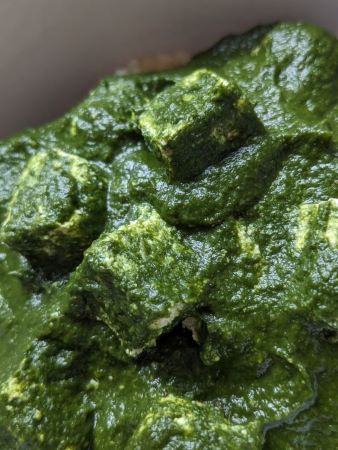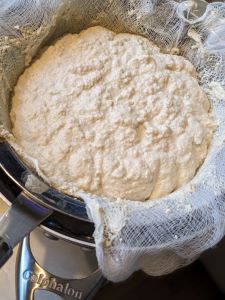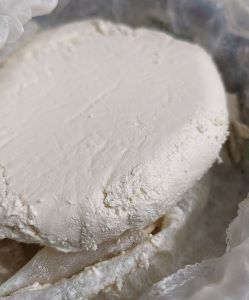Recognizing that to veganize is to inauthenticate sometimes, I resolved to veganize paneer. And for whatever success I had, I have to recognize that I did not create paneer.
Paneer is a dairy-based preparation.
It’s a celebration of North India, a gastronomic reward from this land for its people who cultivate it in part by raising livestock and imparting their creativity on what their animals yield. Using pure soy milk instead of whole milk is more than a substitution: it’s an omission of critical aspects about a culture that inform its cuisine.
In this case, “Does It Vegan?” is shorthand for:
Do the ingredients of my lifestyle function in an authentic recipe well enough to offer me a glimpse into another culinary world?
But no one would remember that URL.
Cookbooks are invitations into such worlds.
When Maneet Chauhan, alongside Jody Eddy, blessed shelves with Chaat: Recipes from the Kitchens, Markets, and Railways of India, she granted readers permission to bring her cooking lessons and techniques home where they would inevitably have to make adjustments (some minor, some major) based on their resources. Even if she were to grace my kitchen, Chef Chauhan and I would be forced to navigate the limitations of my space while making her chaats!
Indeed, no matter how similarly an author and I live and cook, my collection of ingredients and appliances will never be identical thus requiring various workarounds. In some cases, a workaround may be impractical or impossible for a recipe to produce edibles at all –
Yet more often than not, adaptions can be made!
My plant-based result may be inauthentic to the original creator, but it is undoubtedly an authentic reflection of me.
That is vegan “paneer”. It’s not paneer. It’s an expression of paneer inspired by Chef Chauhan who celebrates her culture in a cookbook that I aim to embrace as best I can.
But no one would remember that search prompt.
About This Variation
My goal, after swapping pure soy milk for whole milk, was to preserve as much of Chef Chauhan’s recipe as I could. I otherwise followed her recipe exactly noting when my ingredients responded in ways other than what she teaches to expect.
Consequently, this is her recipe. It just also (with a few tweaks) can be successful with pure soy milk –
as long as you use pure soy milk!


Pure soy milk is soy milk with a 2-ingredient ingredients list:
- water
- soybeans
That’s it!
Any other additives will interfere with curdling; any other non-dairy milk will not curdle as well…if at all.

Veganization: “Paneer”
Description
This vegan "paneer" is an expression of paneer inspired by Maneet Chauhan who celebrates her culture in a cookbook I aim to embrace as best I can. Pure soy milk is critical for success; do not use another non-dairy substitute.
A yield between 8-12 oz/227-340 g can be expected depending on how much pressure can be applied in Step 3.
Ingredients
Instructions
-
In a medium saucepan, heat the milk to 195°F/91°C over medium heat. Using a wooden spoon, stir frequently during the heating process to prevent the milk from burning. Be sure to scrape the bottom of the pan when you stir because this is where the milk is most prone to sticking.
-
Remove from the heat and stir in the lemon juice until evenly distributed, which will cause the separation of curds from the "whey". The process should begin right away, but don't fret if it takes a minute or two. Cover the pan and set aside at room temperature for 10 minutes to let the acid work its magic. Check the mixture at this point: The curds should have completely separated from the "whey". Don't panic if this hasn't happened completely yet. Simply add another teaspoon/2.5 mL of lemon juice and set aside for a few minutes more. This should do the trick.
-
Line a fine-mesh sieve with cheesecloth and set the sieve over a bowl. Ladle the curds and "whey" into the sieve. Reserve the "whey" for another use. (SEE: Note.) Season the curds (still in the sieve) with the salt, stirring it in using a wooden spoon, then gather up the edges of the cheesecloth into a tight bundle and squeeze the excess "whey" from the curds. Place the cheesecloth and curds on a large plate and, if desired, shape into a square. Wrap the cheesecloth edges around the paneer and place a second plate on top to compress it. Set aside at room temperature for 6 hours, then refrigerate for an additional 6 hours draining the bottom plate periodically.
A nut milk bag works in place of cheesecloth. -
After 12 hours, the need to drain should have stopped or dramatically slowed. The "paneer" is ready to use or it can be refrigerated in a covered container for up to two days.
Note
The strained water - or "whey" - is quite versatile! After making "paneer", I used my "whey" in place of water to make a meal of Saag Paneer, Basmati Rice, and Chapatis. (I used refined coconut oil whenever a recipe called for ghee.)
Please note, vegan or not, homemade paneer is more delicate than store bought. Gently stir into curries!







